Introduction to the Power Nap
As I write this, I am brimming with mental energy. I don’t have this sort of mental energy all day long, so I have to take advantage of it when I do. As long as I got a good sleep and am healthy, I have this kind of energy about an hour after I wake up (and after a coffee…). Then, there’s another time of day where I have this kind of energy again. It’s right after my power nap. I’ve been power napping for over ten years. Not every day, but whenever I can make it happen or really need it. It’s almost always in the early to mid afternoon, and takes at most twenty minutes, and usually more like fifteen. I simply let go, nod off, and I’m back, refreshed.
It’s a skill I’m quite proud of. I can do it almost anywhere, as long as it’s socially acceptable (and I sometimes push the limits). The return on investment is huge – in less than twenty minutes I can dispose of the afternoon slump and come back pumped, or at the very least able to keep going. Even when I’m sick or way overtired, I buy myself a little time where I can focus and even be creative. While a lot of people are likely nodding along and agreeing with how great power naps are, other people respond differently. I get a lot of “I could never do that”, or “it doesn’t work that way for me”, or “naps make me groggy”, or “you’re so lucky”.
I’m not so sure I’m lucky. Well, I’m lucky that I discovered this at a young-ish age (20) and have been using it for over ten years, but I don’t think my physiology is unique, nor are my sleeping patterns. I think we all have this ability, but we must hone and practice this skill before it becomes second nature.
How I Discovered Power Napping
I remember the day I discovered power napping clearly. It was during my first degree at university. I was working out very hard every day (sometimes twice) and was dealing with a good amount of resulting exhaustion. Now, I should add that I was certainly over-training at the time, but I didn’t know it yet (that realization came around age 24). Over-training lead to some sleeping issues, so I was usually tired at school. I was majoring in physics and taking five courses, so I was blasting my body in the gym, and my brain at school. Very challenging, but I love intensity, so it suited me (at the time…).
My Schedule at the Time
I recall “sleeping” (if it went well) from midnight to 7 am during those years. I would get up and drink coffee/eat breakfast, and have a few hours of feeling reasonably awake and alert. Then I would crush the gym after my morning classes at 11 am, eat a monster lunch, and be overwhelmed with fatigue. My afternoon classes started at 1:30 pm, and continued on until after five. I quickly noted that in my fog I could not pay attention or absorb anything in my afternoon classes, which was rough because it was challenging material, and I didn’t have all the time in the world to catch up after class (I had to hit the gym again, and chill with my homies! Life was busy).
The Chemical Coping
At first, I combated this problem with caffeine. I would simply get a giant cup of coffee, and drink it right after my monster lunch. It helped, but it didn’t feel healthy. I would be awake, but scattered and wired, and it didn’t make getting to sleep at night any easier. Over time, I could tell I was building a tolerance to the caffeine as well. I refused to cut back on training (at the time I thought that maximum exercise meant maximum health, whoops), so I decided to just ditch the coffee and see what happened.
The Breakthrough
The first couple days were rough, the afternoons were a blur, and I thought I was hooped. Then, one fine day, I was in my 1:30 pm classical mechanics course, and struggling to stay awake. Struggling so much, in fact, that I stopped caring about what others around me thought, and just leaned back in my seat (head down in front), and let go. Within moments, I was sitting and chatting with Cosmo Kramer and having a laugh (*cue dream sequence*). I then experienced a body shudder, and was back in class. To my astonishment, I had actually briefly slept, but it had been less than ten minutes. My professor was still lecturing away, and I felt good! My mood was much more positive, I was able to focus and catch up in the note taking, and even contributed to a class discussion. I used the beginning of that class for a nap for the rest of the semester, and similar classes (or library study areas, or even bathrooms) for the rest of my academic career. Heck, I have a job, and I’m still doing it.
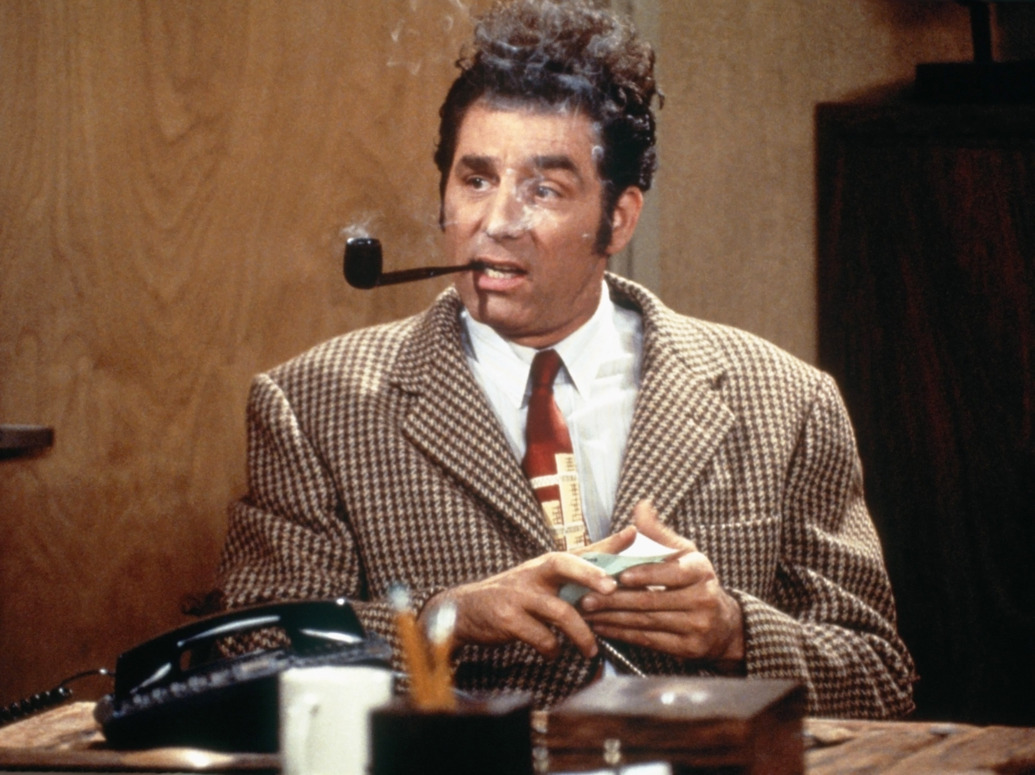
A few classmates laughed at me (and colleagues still do) for “being lazy”, or whatever. That didn’t bother me as I knew I had discovered a powerful tool. Being the knowledge hungry person that I am, I read up on what happened to me and learned that quite a few highly-productive people used this tool frequently. I had discovered the power nap, and it changed my life.
What is the Power Nap?
Simply put, and as described above, a power nap is a short (less than 20 minutes) nap where you only enter the lightest stages of sleep for a brief time. The advantage of this is that the brain can quickly refresh itself, but since it doesn’t enter the deeper stages of sleep, you avoid the grogginess associated with sleep inertia (sleep inertia wants to keep you asleep, this is where the “napping makes me groggy” quotes come from). In Sleep Series – Part 2, I outlined the science of sleep architecture which describes the different stages of sleep.
Namely, in a night’s sleep, we go through sleep cycles of about 90 minutes which are made up of different sleep stages (stage 1, stage 2, stage 3, and REM sleep). Stage 1 and 2 are the light stages. When woken from stage 1 or 2 sleep, sleepers do not exhibit much or any grogginess. When woken in stage 3 or REM sleep, sleepers resist waking up, and even if they do, it takes time to get rid of the sleep inertia and become alert again.
So there’s a sweet spot where you dip into stage 1/stage 2 sleep, and then get up before you slip into the deeper stages. Your brain gets a chance to “reset” (my term) or “clear the cobwebs” (a former colleague’s term), without going into the serious stages which take a long time to come back from.
Who Else Power Naps?
The power nap is surprisingly common. You may have heard of the ‘siesta’ in countries that have a hot climate. People dip out during the hottest hours of the day for a nap and chill sess (granted, a lot of them take more than 20 minutes). On top of that, some prolific minds were apparently big fans of the power nap. Names include: Thomas Edison, Napoleon Bonaparte, Winston Churchill, John F Kennedy, Ronald Reagan, Salvador Dali, Albert Einstein, Margaret Thatcher, and Eleanor Roosevelt. I’ve read that Edison mostly slept 4-5 hours a night and took a couple power naps during the day, and that’s it!
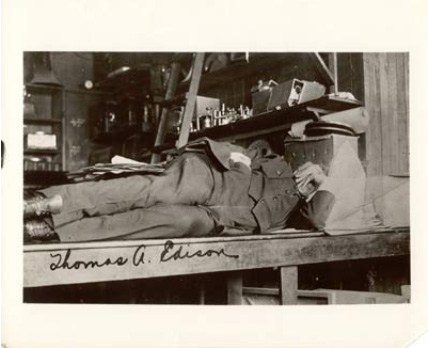
Image: Henry Ford Foundation
Circadian Rhythm of the Power Nap
Now, is the power nap natural? Well, along with certain hormones, our body temperature has a circadian rhythm. We cool off in the evening, reach our lowest temperature a couple of hours before waking up, and warm up through the morning. Just after noon, however, there is normally a dip in body temperature, which is usually when people start yawning and losing steam. Check this figure out:
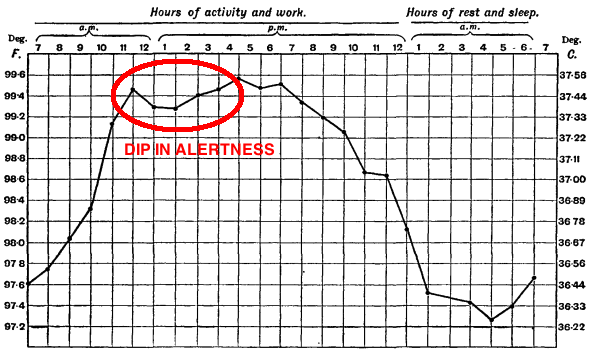
That’s almost always when I’m feeling a power nap! It really pops you out of it. No more struggling for two hours before you get your steam back. Twenty minutes, and you’re ready to rock again (assuming you’re otherwise healthy). On top of the afternoon dip, I’ve taken power naps at all times of day if I felt I needed it, and it’s almost always worked well. The only thing I’d recommend is not to power nap too close (3 hours-ish) to your intended bedtime, as you might be too alert to fall asleep normally.
What are the measured benefits, though? How do we know that these power naps are really helping us, and aren’t a waste of time?
A Look at the Research
Effect on Memory
I dug up a few studies on short-duration sleep. First up: An ultra short episode of sleep is sufficient to promote declarative memory performance. What do they mean by ultra short? Well, they showed test subjects a list of 30 words, and then 60 minutes later tested them on recalling those words. Compared to a waking condition during those 60 minutes, a nap as short as 6 minutes provided a significant advantage. Longer naps helped more, but 6 freaking minutes of light dozing was enough to consolidate the memories in a manner that was advantageous on the test. That’s a good use of time in my books.
Stage 1 vs Stage 2
A Japanese study measured whether power-nappers dipped into stage 2 sleep, or just stayed in stage 1 after a night of restricted sleep (1.5 hours less than “normal”). According to their results, both types of power naps improved subjective feelings of alertness and mood, the very brief stage 2 session was responsible for increased mental performance. So, a little stage 2 is good, but not too much, or you risk going into the deeper stages. Personally, I think most of my power naps are just stage 1, but some feel deeper and might have a touch of stage 2. I think that only happens when I really need it though.
The Rest
NASA researchers looked into all the different variables involved with which types of naps and when, and came up with some serious strategies to optimize performance in 24-hour operational settings. They call it alertness management. I like it!
Enter the “nappuccino” – researchers are suggesting that combining caffeine and a short nap (>15 minutes) reduces sleepiness in drivers. On long drives, I have definitely been known to pull over and power nap, then slam a coffee. You will drive well in this state. Trust me.
Not exactly research, but companies such as Google, Proctor and Gamble, and the Huffington Post now provide nap rooms for their employees. No need to hide it! Oh man, that sounds good to me.
How to Power Nap: For Beginners
I’m sure there are countless methods for power napping, but I’m going to speak from my experiences, and offer an option from Salvador Dali.
My Technique
You know when you’re falling asleep at night, and you find yourself dozing off, but unless you’re zombie tired, there’s a few doze-offs before you actually konk out? Well, your power nap is this: no more than 1-2 doze offs, then get UP! Anymore than that, and you risk the deeper stages. Ideally, you get the “body shudder” that I occasionally experience. That’s your best cue that your power nap is over. I don’t get it every time, but when I do, I know it was a killer power nap. Those are the beauties. Power naps without the shudder are very helpful and restful as well, but there’s something exhilarating about that shivery jolt…
As a beginner, you might be concerned about knowing where the line is. That’s why I recommend power napping in a not-so-comfortable position. This way you can only really get a couple of dozes in as you’re not comfortable enough to really sleep. Power nap in your chair or on the bus. Power nap on the can in the bathroom. Power nap at the library. Power nap under a tree in the park (no pillow! Too comfy).
For me, where I work there is no nap room (sigh…). SO – right next to my desk there is a staircase that is rarely used, and I have adapted to taking my power naps right on those stairs. I call them stair naps! How do I do this, you may ask? Look below to see the brilliance (note to any higher-ups at the company – I do this for productivity, not to avoid work).
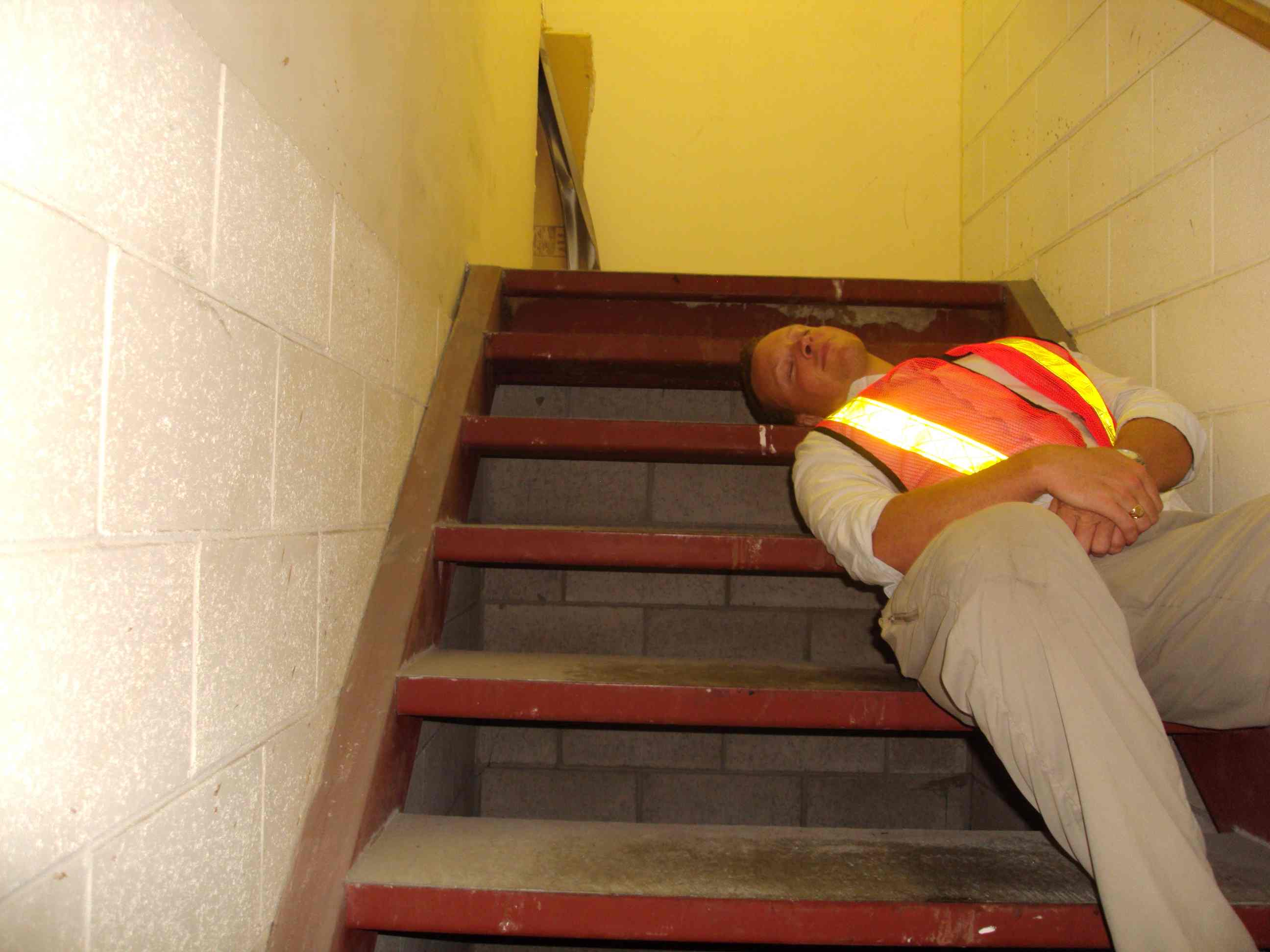
Salvador Dali’s Method
Another technique that Salvador Dali used was to hold a heavy key in his hand while sitting in a chair. Under his key-holding hand, there would be a plate. When he entered stage 1 sleep, his body would relax and he’d drop the key. The key would hit the plate with a *clang* and he would blast out of his chair and paint things. He loved it. That’s an extremely short nap, indeed.
Parting Remarks
No matter how you do it, you’ll get better with time. After a few months of practice, I knew right when to get up to feel refreshed. I have gotten through periods of heavy work, stress, and sleep restriction with power naps leading the way. When I have a cold and feel crappy and need to work on something, a power nap will give me a bit of time where I have some energy. Not an instant cure, but it really helps.
Anyone out there a power-napper? Let me know how you do it in the comment section. For all others – I strongly recommend giving it a try, and if at first you don’t succeed, try, try again.
Graham
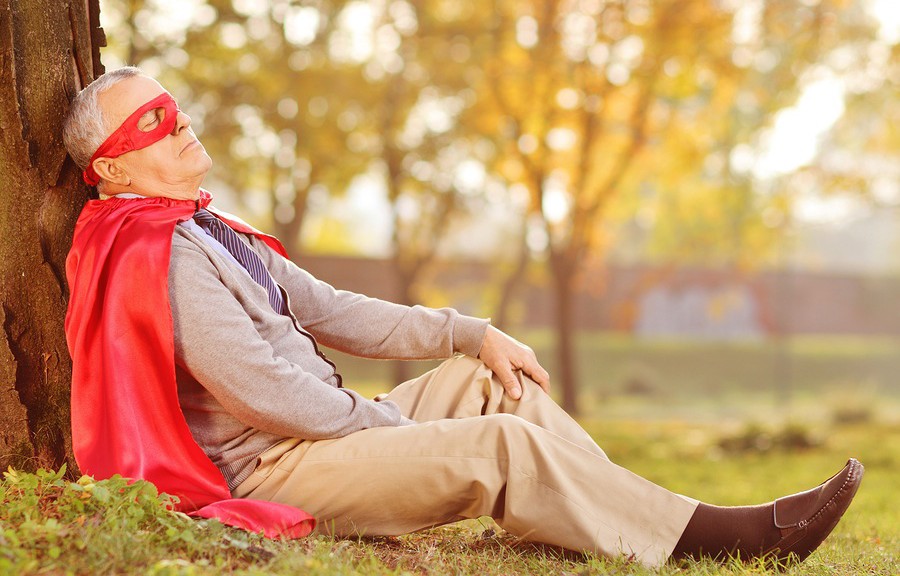
Hi Graham,
Great blog post! I’m writing book on powernapping. Would you be interested to edit the English version?
Cheers, Kasper
Hi Kasper,
Thanks for the comment!
Email me at [email protected] and let’s see where this takes us.
Thanks,
G